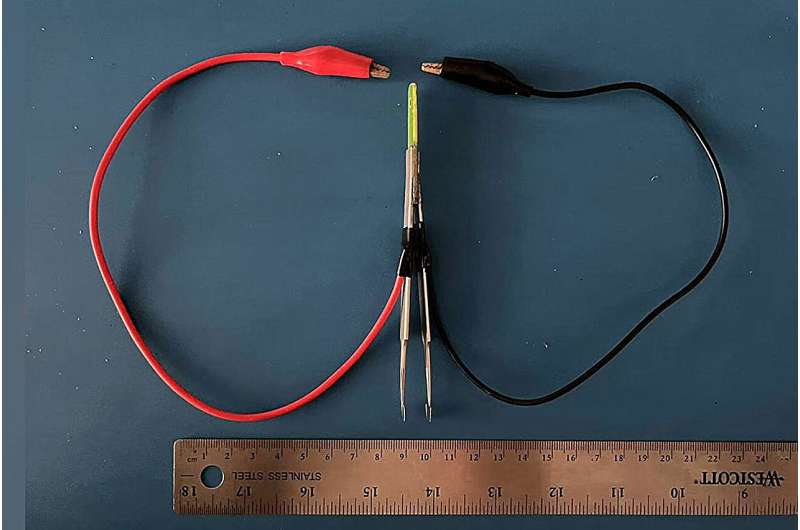
Although lithium-metal batteries aren’t available on the market yet, they promise to tackle one of our biggest frustrations: a quickly draining battery. These batteries are related to the lithium-ion batteries commonly used in many electronic devices, but they could potentially store double the energy. However, one major hurdle has been their limited ability to endure multiple charges.
A recent study led by scientists at the California NanoSystems Institute at UCLA (CNSI) may help speed things up. In the journal Science Advances, the researchers introduced a groundbreaking method that captures images of a lithium-metal battery while it’s charging, in incredible detail that’s smaller than the wavelength of light.
This technique, known as electrified cryo-electron microscopy (eCryoEM), could provide insights into designing more efficient lithium-metal batteries. Strengthening domestic research in this area could give the U.S. an advantage in battery technology, currently largely controlled by companies in China. This research could even have implications beyond batteries, including neuroscience.
Yuzhang Li, an assistant professor at UCLA’s Samueli School of Engineering and a CNSI member, shared insights about the study’s significance.
Why pursue this research?
China dominates nearly 80% of the global lithium-ion battery supply chain. Competing with them poses a significant challenge, particularly as the U.S. moves towards electric vehicles and large-scale energy storage. Lithium-metal batteries could potentially offer the U.S. a chance to leapfrog existing lithium-ion technology, effectively doubling battery energy density. The issue, however, is that lithium-metal batteries currently can’t be cycled as many times as lithium-ion ones.
While lithium-ion batteries can be charged thousands of times, lithium-metal batteries typically last only about 200 cycles at best. This is largely because lithium metal is highly reactive, leading to the formation of a corrosive layer that interferes with the battery’s operation—a major area of research right now.
What sets eCryoEM apart from earlier cryogenic electron microscopy techniques?
Prior methods of cryo-electron microscopy have been similar in physical sciences and biology. For batteries, earlier techniques essentially assessed the initial and final states of electrochemical reactions, missing the ongoing processes during charging.
In developing this new technique over the past four years, we focused on freezing a battery while it charged by submerging it in liquid nitrogen. This required creating a thin battery that could freeze quickly, on the milliseconds scale, while ensuring no unwanted side reactions occurred. We froze batteries at various points in time, essentially creating an animation of the corrosion layer’s development.
What did you discover?
We observed two different electrolyte chemistries: one performed well with about 100 recharges, while the other only managed around 50. The leading theory suggested that the difference rested on the corrosion layer’s properties. This layer allows lithium ions to pass through but limits electron flow, preventing extensive reactions with the lithium metal.
Using eCryoEM, we tracked how thickness of the corrosion layer changed over time. In early stages, growth was limited by how quickly lithium could react, but once the layer became thick enough, electron diffusion became the bottleneck. Interestingly, we found that during the diffusion-limited stage, the growth rate was only about 10% slower with the better-performing electrolyte. However, during the earlier stage, the difference was threefold, which was unexpected.
What are the possible implications for improving lithium-metal batteries?
Traditionally, researchers have focused on tweaking the corrosion layer to optimize electron flow. Our findings suggest that instead, we should concentrate on making the liquid electrolyte as reactive-free as possible. While this isn’t a new idea, our study highlights just how significant that focus could be.
Could the eCryoEM technique have broader applications?
This electrified cryoEM could lead to advancements in materials science. My team is keen on understanding molecular processes in various applications, including supercapacitors and converting carbon dioxide into fuel, with support from a Packard Fellowship.
What excites me the most is the potential to benefit the biological sciences. Much of my career has relied on traditional cryoEM which is crucial for structural biology.
How are you planning to contribute to biology?
Like batteries, brain function is fundamentally based on electrical activity. Our idea is to stimulate a brain cell at various voltages and instantaneously freeze it. Observing changes in protein shapes that regulate ion movement can deepen our understanding of brain function, potentially leading to insights for new therapies.
The co-first authors of this research are UCLA doctoral students Chongzhen Wang and Jung Tae Kim, with additional contributions from Xintong Yuan, Jin Koo Kim, Bo Liu, Min-ho Kim, and Dingyi Zhao, all at UCLA.
For more information:
Chongzhen Wang et al, “Trapping and imaging dynamic battery nanointerfaces via electrified cryo-EM,” Science Advances (2025). DOI: 10.1126/sciadv.adv3191
If you would like to see similar Tech posts like this, click here & share this article with your friends!

